Information / Iron casting
Cast Iron casting
Cast iron is an alloy of iron with a carbon to carbon ratio of at least 2.14%. Mostly metal is divided into 2 types: gray and white. In the first, the silicon and graphite content is from 2.9 to 3.7%.
On the main page, we have given a sequential description of the stages of work.
Here, we want you to familiarize yourself in detail with the basic methods of iron casting:
Casting in molds from a clay-sand mixture;
Gypsum, or shell form;
Metal protected form;
Under pressure;
Inside the mold itself, we place a model of the finished product, which repeats it, but is larger in size according to the amount of casting shrinkage.
The mixture is compacted and compacted so that it completely adheres to the model. Next, we carry out casting through the holes (sprues).

Products made of high-strength cast iron are produced using the method of casting into a gasified model, using molds from a sand mixture.
In order to improve its properties, high-strength cast iron undergoes heat treatment:
We heat the material to 850 °C;
We keep it warm for several hours;
Let cool with mineral oil at 350°C;
This method helps us relieve the internal stress of the metal, and protect ourselves from the appearance of cracks in the application, as well as increase its homogeneity.
You may be wondering what are the benefits of cast iron?
- Durable product quality;
- Reasonable and very affordable prices;
- Wear resistance and strength;
Ultimately, industries that in the recent past have chosen steel over cast iron. Over time, however, they return to old and proven material.
Professional equipment helps to produce material in large volumes, without neglecting quality.
Request a call
Our contacts
News
About the company
Plastic or cast iron sunroof?
Rain receivers. And is it really necessary?
Need some advice?
Do you have any questions, need advice or consultation on cast iron products? Our experts are ready to provide you with all the necessary information and solve any problems in this area

If you need high-quality cast iron products and a reliable partner, contact us. We will be happy to help you bring your projects and goals to life.